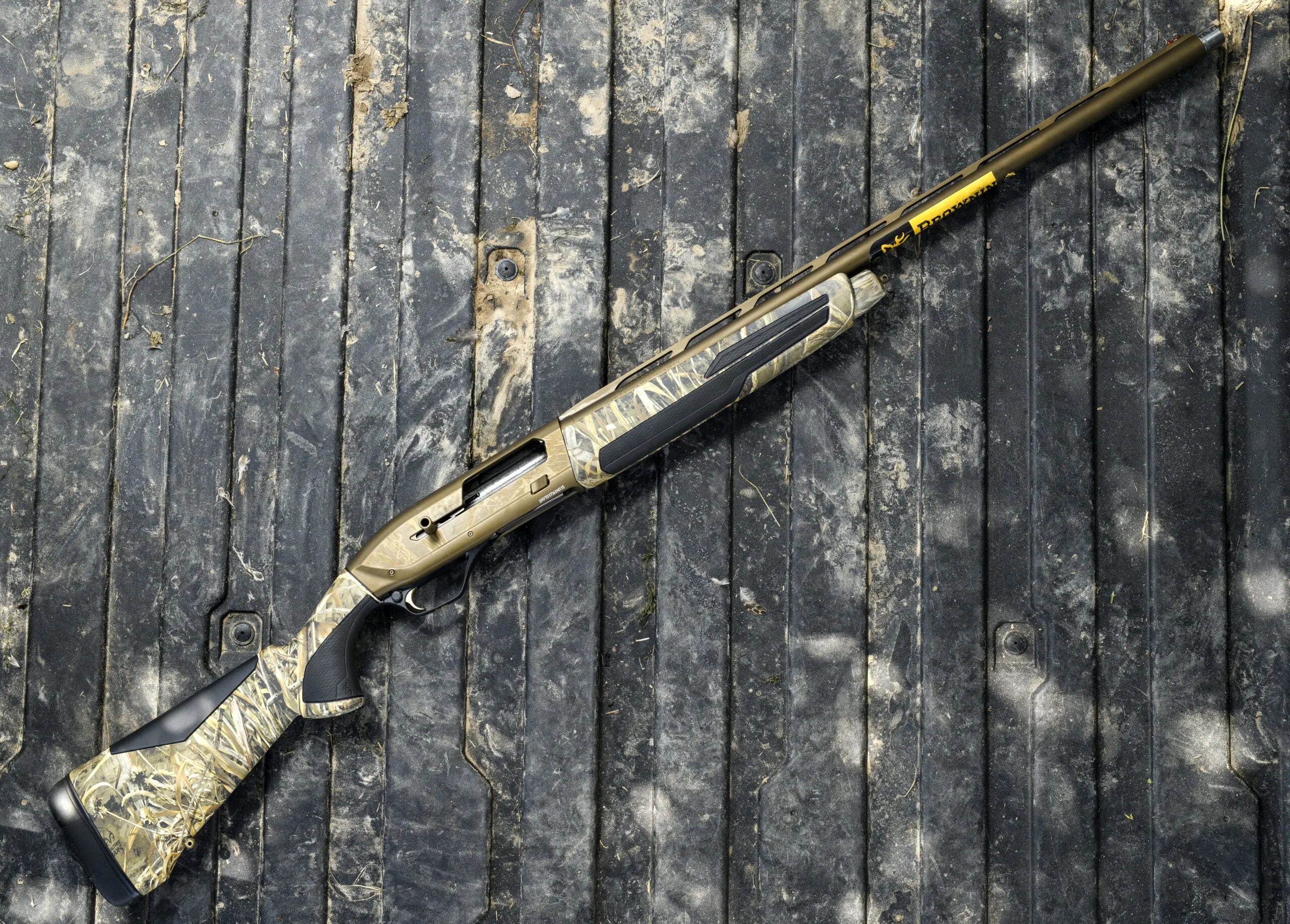_We may earn revenue from the products available on this page and participate in affiliate programs. Learn more ›
_
was, for me, one of the biggest, most pleasant surprises of our waterfowl shotgun test
. Never bowled over by the original Maxus, I was ready to be unimpressed. Instead, I loved the Maxus II. That the Maxus II didn’t win the top-of-the-line semiauto category is a testament to just how good duck guns have become. The Maxus II is a terrific choice for waterfowlers and as an all-around hunting shotgun.
invented the semiauto shotgun at the turn of the 19th century, and his long-action, recoil-operated gun dominated the market for decades. Yet the company struggled to compete in the gas-gun market, which took off in the ’60s with the game-changing Remington 1100. In the 1980s, Browning even went so far as to have Beretta make a gas gun for them, the B-80, which was nothing more than a Beretta 303 with a humped receiver that looked like a Browning. After failing with the B-2000 and the A500G, Browning finally came up with a good gun in the Gold in the 1990s. The Gold was spun off into the excellent Silver, as well as the popular Winchester Super X2/3/4 series, then was replaced by the Maxus in 2009.
The Maxus II corrects the most obvious drawback of the Maxus—the lack of a magazine cap—and adds several other refinements to an already sound design. The Maxus II combines moderate weight and good recoil reduction and can serve as an all-around shotgun for waterfowl, dove, upland, and turkey hunting as well as for clay target shooting. It’s available in 3- and 3 ½-inch 12 gauge, in synthetic and walnut stocked versions. There’s a sporting clays version as well.
Nuts and Bolts on the Browning Maxus II

Specs on the Browning Maxus II
Gauge: 3-inch and 3 ½-inch (tested) 12-gauge
Action: Gas semiauto
Capacity: 4+1
Chokes: Browning Invector Plus Extended, IC, M, F
Barrel: Flat rib, front fiber-optic bead
Barrel Lengths Available: 26 and 28 inches (tested)
Finish: Black synthetic, carbon fiber synthetic (sporting model only), walnut, camo, camo and Cerakote Wicked Wing (tested)
Length: 47.25 inches
Length of Pull: 14.4 inches
Trigger Pull: 6.4 pounds
Overall Weight: 7.4 pounds
A gas-operated gun, the Maxus II has a reliable system Browning calls the Power Drive. The heart of the system is a piston on the magazine tube with a stout spring inside. The spring compresses to vent excess gases from very heavy loads so the gun can shoot anything from light target loads to turkey magnums. A composite sleeve links the piston to the bolt. There’s a spring to return the sleeve, and that’s it for the gas system. It’s simple, it works, and it’s easy to clean. Because the moving parts of the action store, then release, recoil energy, the recoil signature of a gas gun is more of a drawn-out shove than a sharp kick. Even so, not all gas guns reduce recoil equally. The Maxus II is very soft-shooting, both due to the gas system, a few extra ounces of weight, and the soft comb pad and buttpad on the gun that protect your cheek and shoulder.
As I mentioned, the gun has a standard magazine cap, unlike the original Maxus, which had a forend with a latch on it that looked slick but couldn’t accept accessories. With the new Maxus II, snow goose hunters or anyone else who wants to add a magazine extension can do so, and sporting clays shooters can add a weighted magazine cap once they are available aftermarket.
Other smart changes to the original also include the new stock profile, which as a parallel section at the butt, meaning you can have it cut shorter and still use the same factory pad without having to grind it to fit. The gun also has the enlarged bolt handle, loading port, and bolt release button that everyone wants on a waterfowl gun these days, as well as the classic Browning semiauto features of a magazine cut off and speed loading. The cutoff lets you unload the shell in the chamber without cycling the next one, so you can drop in a special load or make the gun safe for crossing a fence in the uplands. With the speed-loading feature, you can thumb a shell up the magazine tube of an empty Maxus II and it will be whisked up into the chamber. The safety reverses for left-hand use more easily than any other semiauto safety, the button is big and easy to use, and the trigger breaks at an adequate 6.4 pounds.
How We Tested the Maxus II
The Maxus II is a waterfowl gun, so naturally we had to take it duck hunting. Since we tested in September, a Texas teal hunt at the Pintail Hunting Club
in Garwood seemed like the place to go. The club also had a clays range were we could shoot the gun as much as possible in the afternoons in a vain attempt to make it not cycle. We also patterned the gun, and tested its point of impact.

We patterned the Maxus II at 35 yards. Stephen Maturen
It cycled 1-ounce target loads with no problem as well as 1 ¼-ounce steel and steel and bismuth HeviHammer ammunition. Through hundreds of test shots, the gun functioned perfectly and kicked softly due to the gas action and the soft cheek and buttpad.
We patterned the gun from a Lead Sled at 35 yards with hunting loads and the included Modified choke. It printed a flat 50/50 pattern right on the point of aim, which is good for ducks and something to keep in mind if you want a gun to hunt both ducks and turkeys with. The patterns with Federal Speed Shok
3-inch, 1 1/8-ounce, 1550-fps loads of 2 shot produced a tight 85 percent pattern. Prior to the test, I had also had the opportunity to shoot a different Maxus II for a couple of days on a sporting clays course during a TV shoot. I had no problems either with the gun or with hitting targets with the gun through a few hundred rounds.
How the Gun Performed
Handling and Ergonomics
At a few ounces under 7 ½ pounds, the Maxus II is heavy enough to shoot and absorb recoil and light enough to carry in the field. The soft comb seems especially effective in recoil reduction. The stock was a good fit for all of us out of the box, and the flat-shooting Maxus II was easy to put on target. The 28-inch barrel provided the right amount of weight forward to help the gun swing smoothly. The synthetic stock had rubber grip panels inlaid to make the gun easy to hold onto when wet. In early season Texas, it’s more likely that moisture will be sweat, not rain, but the panels worked as designed. The enlarged controls and speed loading feature make the gun a snap to load, unload, and shoot. It would be an easy gun to use in weather much colder than what we experienced on our hunt. Another handy feature carried over from the Maxus is the “Turn-Key” magazine plug, which, per its name, you can remove with any key without risk of launching a magazine tube spring.
Workmanship and Aesthetics
It’s a hallmark of Browning guns that they are well fit and finished—even if that doesn’t mean the same thing did when all guns were made of walnut and blued steel. Nevertheless, everything about the way this gun is put together says “quality.” We had the top-of-the-line Wicked Wing version, Max 5 camo with black grip and comb inserts, complemented by bronze Cerakoted metal that gives the gun a striking appearance. The overall lines of the gun are pleasing, too, perhaps not quite so much so as the original Maxus, with its slim, angle-tipped forend, but the utility of the magazine cap more than makes up for any aesthetic shortcoming of the redesign. I have since seen the gun in wood and in all-camo; and the vintage camo pattern version is especially appealing.
Reliability
The Maxus II ate everything we fed it and spit out the empties. Honestly, although we ran plenty of hunting loads through the gun in the field, shooting six teal in a hunt that lasts 40 minutes isn’t much of a hunting torture test. We did our best to make up for it by shooting the gun a ton at clays in the afternoons at the Pintail Hunt Club, and we weren’t able to make it malfunction at all.
Value
The Maxus II isn’t a value so much as it’s worth what you pay for. You get reliable performance with a wide range of ammunition in a package that’s easy to shoot well. Recoil is minimal and the new ergonomic extras like the enlarged bolt handle and release button go well with the established Browning improvements of speed loading, the Turn-Key magazine plug, and the readily reversed safety. It also adds shims and spacers to help with fit.
What the Maxus II Does Best
The Maxus II is a versatile shotgun, but its true home is the duck blind, especially in the Wicked Wing configuration we tested. The Wicked Wing’s Cerakote metal can withstand the moisture and abrasion typical of waterfowl hunting, while the reliable gas system of the Maxus II can cycle heavy loads reliably and without undue recoil. And, now that the old-style latch is gone and there’s a regular magazine tube and cap on the gun, you can extend the Maxus II and extend your season into spring snow goose hunting if you want to.
What it Does Worst
While most people would have no problem carrying a Maxus II in the uplands, there are lighter semiautos out there. The Maxus II’s stablemate, the inertia operated A5, for instance, weighs over half a pound less and would be a better gun for pheasant hunting or even running and gunning for turkeys. But, gun weight is a trade-off. That same extra weight that helps make the Maxus II a soft-kicking gun and a little smoother to swing also means it’s a bit more of a burden to carry.
Final Thoughts on the Browning Maxus II
is both an improvement on the original Maxus and an excellent choice in a gas-operated duck gun. The gun retains all the reliability of the Maxus and improves in on it with several well thought-out features. The recoil reduction, especially, is impressive, and the enlarged controls and suitability for spring snow geese should make it more popular with waterfowl hunters. At the same time, it’s a versatile enough gun to be at home in a dove field, in the turkey woods, and on the clay-target range.
![Field & Stream [dev]](https://images.ctfassets.net/fbkgl98xrr9f/1GnddAVcyeew2hQvUmrFpw/e4ca91baa53a1ecd66f76b1ef472932b/mob-logo.svg)





